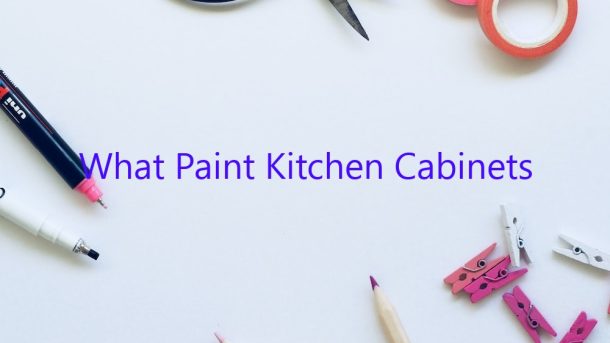When it comes to painting your kitchen cabinets, there are a few things you need to keep in mind. The type of paint you use will affect the look and durability of your cabinets. You will also need to decide whether to paint the cabinets yourself or hire a professional.
The most important factor to consider when choosing a paint for your kitchen cabinets is the type of finish you want. Semi-gloss and high-gloss paints are the most durable and are best for high-traffic areas. They are also easy to clean. If you want a more subdued look, choose a matte or eggshell finish.
Another factor to consider is the color of the paint. White is a classic choice that will never go out of style, but black or another dark color can create a dramatic look. You can also choose a color that matches your kitchen appliances or flooring.
Before you start painting, you will need to remove the cabinet doors and hardware and sand the surfaces to be painted. If you are using a spray paint, be sure to use a mask to avoid breathing in the fumes. Apply a primer to the surfaces to be painted, and then paint the cabinets with two coats of paint. Let the paint dry completely before reassembling the cabinets.
Contents
What kind of paint do you use on kitchen cabinets?
When it comes to painting your kitchen cabinets, you have a few different options to choose from. The most popular option is to use a latex paint, but you could also use an oil-based paint or a lacquer.
Latex paint is the most popular option because it is affordable, easy to use, and durable. It is available in a wide range of colors, and it can be used on both wooden and laminate cabinets. Latex paint is also easy to clean and resistant to moisture.
If you want a high-gloss finish, you should use a lacquer. Lacquer is durable and resistant to moisture and scratches, but it is also expensive and can be difficult to use.
If you are painting wooden cabinets, you should use an oil-based paint. Oil-based paint is durable and resistant to moisture, but it takes longer to dry than latex paint. It is also more expensive than latex paint.
Can I just paint over my kitchen cabinets?
So, you’re thinking about painting your kitchen cabinets? Great idea! Cabinet painting is a cost-effective way to give your kitchen a new look. But can you just paint over your existing cabinets, or do you need to remove the old paint first?
In most cases, you can just paint over your existing cabinets. However, it’s a good idea to remove the old paint first, especially if it’s chipping or peeling. Removing the old paint will give your new paint job a longer life.
If you’re not sure how to remove the old paint, there are a few ways to do it. You can use a chemical stripper, a heat gun, or a sandblaster. Or, you can hire a professional to do it for you.
Once the old paint is removed, you can start painting your cabinets. Be sure to use a primer first, then paint them with a quality latex paint. Use a brush or a roller to apply the paint, and be sure to get into all the nooks and crannies.
And that’s it! Your kitchen cabinets will be freshly painted and looking like new.
What’s the best finish for painting kitchen cabinets?
When it comes to painting your kitchen cabinets, there are many finish options to choose from. In this article, we will discuss the pros and cons of each finish type, in order to help you make the best decision for your cabinets.
The most popular finish for kitchen cabinets is a glossy paint finish. Glossy finishes are durable and easy to clean, and they add a bit of shine to your cabinets. However, they can also be a bit difficult to work with, and they can show every fingerprint and smudge.
If you are looking for a more durable finish, a satin or semi-gloss finish may be a better option. These finishes are less glossy than a glossy finish, but they are still durable and easy to clean. They also tend to show fewer fingerprints and smudges than a glossy finish.
If you are looking for a low-maintenance finish, a matte finish may be a good option. Matte finishes are not as durable as other finishes, but they are easy to clean and they resist fingerprints and smudges.
If you are unsure which finish is best for your cabinets, we recommend contacting a professional painter for advice. They will be able to help you choose the finish that is best suited for your needs and your cabinets.
What kind of paint do professional cabinet painters use?
Professional cabinet painters use a variety of paints, depending on the type of cabinet they are painting. In general, they use paints that are durable, moisture-resistant, and that will not chip or peel.
One type of paint that professional cabinet painters often use is latex paint. Latex paint is durable and can be used on both interior and exterior surfaces. It is also moisture-resistant, which makes it a good choice for cabinets that will be exposed to humidity.
Another type of paint that professional cabinet painters may use is oil-based paint. Oil-based paint is durable and can also be used on both interior and exterior surfaces. However, it is not as moisture-resistant as latex paint, so it may not be the best choice for cabinets that will be exposed to humidity.
Professional cabinet painters may also use specialty paints, such as high-gloss paint or metallic paint. High-gloss paint is durable and has a high sheen, making it a good choice for cabinets that will be seen from a distance. Metallic paint is also durable and has a high sheen, but it is also reflective, which can make it a good choice for cabinets that will be seen from different angles.
Ultimately, the type of paint that professional cabinet painters use will depend on the specific needs of the project.
Should cabinets be satin or semi-gloss?
There are many factors to consider when deciding whether to paint your kitchen cabinets satin or semigloss. The main difference between the two is their appearance: satin paint has a more subtle shine, while semigloss paint has a more glossy finish.
Some people prefer the look of satin cabinets because they are less flashy than semigloss cabinets. They can also help to make a small kitchen look bigger, because the light reflections are softer and less intense. On the other hand, semigloss cabinets can add a touch of elegance to a kitchen and make it look more polished.
The other main difference between satin and semigloss cabinets is the level of durability. Semigloss cabinets are more resistant to stains and scratches than satin cabinets, making them a better choice for busy kitchens. However, satin cabinets can be more forgiving if they are accidentally bumped or scratched.
In the end, the decision of whether to go with satin or semigloss cabinets comes down to personal preference. Consider the look you are going for, the amount of wear and tear your kitchen will see, and your budget, and then make the decision that is right for you.
Do I need to prime cabinets before painting?
When painting cabinets, it’s important to use the correct primer to ensure the paint adheres well and doesn’t peel or chip. In some cases, you may not need to prime the cabinets before painting, but in others, it’s a necessary step.
If your cabinets are in good condition and aren’t made of a porous material like wood, you may not need to prime them before painting. However, if your cabinets are made of a porous material, have any scratches or chips, or are old and faded, you should definitely prime them before painting.
Primer will help the paint to adhere better to the surface of the cabinets and will help to prevent it from peeling or chipping. It’s a good idea to use a high-quality primer like Zinsser Bulls Eye 1-2-3, which is designed for use on cabinets.
Once the primer has dried, you can then paint the cabinets with your desired color. Be sure to follow the specific instructions on the paint can, as different paints may require different application techniques.
By following these steps, you can ensure that your cabinets will look great and will last for many years.
What happens if you don’t sand cabinets before painting?
If you’re planning to paint your kitchen cabinets, you’ll need to sand them first. This is to ensure that the paint adheres properly and to create a smooth surface for painting.
If you don’t sand your cabinets before painting, the paint may not adhere properly and may peel or chip off over time. The surface may also be rough, which will make it difficult to paint evenly.
It’s important to sand your cabinets thoroughly, especially if they’re made from a wood like oak or maple. Sanding will remove any scratches or blemishes, and will help the paint to look smooth and polished.
If you’re not sure how to sand cabinets, there are plenty of online tutorials that can show you how. It’s a simple process, but it’s important to take your time and to be thorough.
Once your cabinets are sanded, you’re ready to start painting!




